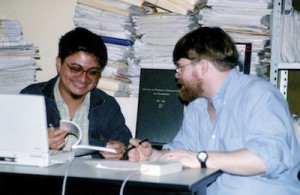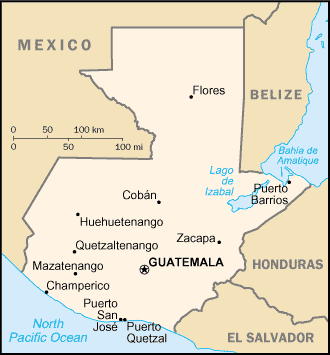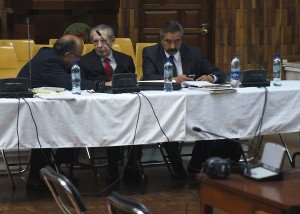
Guatemala
Collecting and Protecting Human Rights Data in Guatemala (1991-2013)

Hugo Cabrera (left) of CIIDH and Patrick Ball, with paper coding forms, documents, photocopies and press clippings, 1998.
In 1996, a peace accord brokered by the United Nations ended 36 years of internal armed conflict in Guatemala. During the hostilities, non-governmental organizations asked for technical support from the scientific community in the project to gather the experiences of witnesses and victims in databases.
From 1993 to 1999 Dr. Patrick Ball, then at the American Association for the Advancement of Science (AAAS), worked with the International Center for Human Rights Research in Guatemala (CIIDH) to collect and organize evidence of more than 43,000 human rights violations. The accounts were collected from press reports, NGOs and victims. In the early 1990s, Patrick re-designed the CIIDH database and helped them to protect the information by encrypting it with PGP encryption software.
The CIIDH database was written in FoxPro for DOS. It ran on laptops with 80386 CPUs, 2 megabytes of RAM, and monochrome screens. In the absence of a network, every night the CIIDH staff ran little programs that integrated the individual laptops’ versions of the database into a master copy. Compressed, encrypted copies of the database were written to sets of five 3.5-inch floppy disks for regular backups. In a world where every computer has fast network connections, gigabytes of RAM, sophisticated user interfaces, and encrypted cloud storage, it is interesting to remember that good information management for human rights was possible with even the earliest computers. With Paul Kobrak and Herbert F. Spirer, Patrick published State Violence in Guatemala: A Quantitative Reflection in 1999 (see Publications for versions in English and español).
The CIIDH project provided a key complementary data source to support the work of the UN-organized Commission for Historical Clarification (CEH). Established in 1996 as part of the UN-brokered peace accords between the government and guerrilla umbrella organization URNG (Guatemalan National Revolutionary Unity), the mission of CEH was to objectively clarify human rights violations and acts of violence in Guatemala. (Cf. CIIDH Datasets.)
In 1997, the Commission asked the American Association for the Advancement of Science (AAAS) to send Patrick to advise them on the development and implementation of an information management system. Patrick worked with the CEH database team to build a systematic approach to classifying the more than 11,000 interviews the CEH conducted. He also helped them create a quantitative analysis based on the testimonies.
In 1998, analysts at the CEH wondered how many deaths had been documented by the CIIDH, the Catholic Church’s REMHI project, and the CEH. It was clear that there were tens of thousands of records of deaths, but how many cases were in common, documented in two or three of the projects? Patrick wrote software, and an analyst from the CEH compared cases randomly sampled from each of the three projects against the other two. Through mutual friends in the American Statistical Association, Fritz Scheuren came to advise Patrick’s work. Fritz pointed out that the emerging data about overlaps among the lists of deaths were ideal for a statistical technique called Multiple Systems Estimation.
Patrick and Fritz worked intensively on the estimation approach during November and December of 1998, with Fritz providing mathematical theory and Patrick managing the data and writing software to use for the analysis. The estimates ultimately formed a central piece of the CEH’s finding that approximately 200,000 people were killed and disappeared during the 36-year conflict. Even more importantly, Patrick and Fritz made a second set of estimates comparing the deaths suffered by indigenous people relative to the deaths suffered by non-indigenous people in the same regions. When combined with the census estimates of the number of indigenous and non-indigenous people alive in those regions, they were able to estimate the total homicide rates against the two communities. The results were published in the CEH’s report in the final section of Vol. XII (see Publications page for the English version).
The results were striking: indigenous communities suffered homicides at rates five to eight times greater than their non-indigenous neighbors. This finding was just what would be expected if genocide had been committed against indigenous people in those regions.
These projects continued when HRDAG became a project of the Benetech® Initiative in 2003.
In the years following the peace accords, Guatemalan human rights organizations continued to experience harassment. Their offices were broken into and their computers were stolen, resulting in the loss of months’ worth of work. In 2004, HRDAG team member Miguel Cruz traveled to Guatemala to help human rights groups set up automated back-up systems that encrypted and transferred their accounting records, their documents and other work files nightly to a secure data storage facility in the U.S.
 HRDAG later trained staff members at Guatemalan NGOs in methods for securing their data with Benetech’s open source information management tool, Martus, which allowed them to create encrypted databases and back this data up remotely to their choice of publicly available servers. This software is still being used in Guatemala, most recently at the Guatemalan National Police Archive project.
HRDAG later trained staff members at Guatemalan NGOs in methods for securing their data with Benetech’s open source information management tool, Martus, which allowed them to create encrypted databases and back this data up remotely to their choice of publicly available servers. This software is still being used in Guatemala, most recently at the Guatemalan National Police Archive project.
In 2011, prosecutors at the Guatemalan justice department (the Ministerio Público) began building a case accusing senior military leaders from the early 1980s of having committed genocide against the Ixil Mayan community in the counties (municipios) of Nebaj, Chajul, and Cotzal. They asked Patrick to re-visit the genocide analysis he did for the CEH twelve years earlier. In addition to the data from the CIIDH, the REMHI project, and the CEH, a much bigger dataset including a list of victims of killing was available from the Guatemalan government’s National Compensation Program (the Programa Nacional de Resarcimiento, PNR).
The mathematical theory underlying MSE had advanced dramatically since 1999, there were several software packages in the open-source R system written specifically to conduct MSE, and data management techniques for finding duplicated records across multiple data sources were greatly improved (see Herzog, Scheuren, and Winkler for examples). Patrick worked with Megan Price and Jeff Klingner to bring all of HRDAG’s experience on record linkage and Multiple Systems Estimation to inform the new estimates.
Read this blogpost (Trips to and from Guatemala) by Megan Price, or this blogpost (Quantitative Research at AHPN) by Carolina López, to learn more about HRDAG’s many years of work, dating back to 2006, with the contents of the Historic Archive of the National Police in Guatemala.
On April 12, 2013, Patrick Ball testified in the Guatemalan Supreme Court in the trial of General José Efraín Ríos Montt. This reportage covers the testimony that took place on April 12, 2013. This Storify covers a sampling of coverage from the testimony. (Read this blogpost to learn more about Patrick Ball’s testimony.)
On May 10, 2013, Gen. Ríos was found guilty of genocide and crimes against humanity and sentenced to 80 years in prison. It was the first time ever that a former head of state was found guilty of genocide in his own country. This New York Times article provides coverage. On May 20, 2013, Guatemala’s Constitutional Court threw out the genocide conviction and prison sentence of Gen. Ríos. (This article and this article explain.)
In September 2013, Patrick Ball testified in a Guatemalan court in the trial of Colonel Héctor Rafael Bol de la Cruz for the 1984 kidnapping and disappearance of Fernando Garcia, a student union leader. He was convicted and sentenced to 40 years in prison. (UN Dispatch. National Security Archive.)
In March 2018, Patrick Ball testified in the re-trial of General José Efraín Ríos Montt and the re-trial of chief of military intelligence José Mauricio Rodríguez Sánchez for the crimes of genocide and crimes against humanity against the Maya Ixil population. In a split decision, Rodríguez Sánchez was acquitted. Ríos Montt died less than a month after the re-trial, in April 2018, and the court closed the case against him.
Publications
> Patrick Ball and Megan Price (2018). The Statistics of Genocide. Chance (special issue). February 2018. © 2018 CHANCE.
> Tamy Guberek and Margaret Hedstrom (2017). On or off the record? Detecting patterns of silence about death in Guatemala’s National Police Archive. Archival Science. 9 February 2017. © Springer. DOI 10.1007/s10502-017-9274-3.
> Patrick Ball, Paul Kobrak, Herbert F. Spirer. State Violence in Guatemala, 1960-1996: A Quantitative Reflection. © 1999 American Association for the Advancement of Science. [pdf – english] [pdf – español]
> Guatemala Memory of Silence: Report of the Commission for Historical Clarification Conclusions and Recommendations. © 1999 United Nations. [pdf – english]
Read all blogposts about HRDAG work in Guatemala.
International Center for Human Rights Research (CIIDH) Data
View datasets here.


